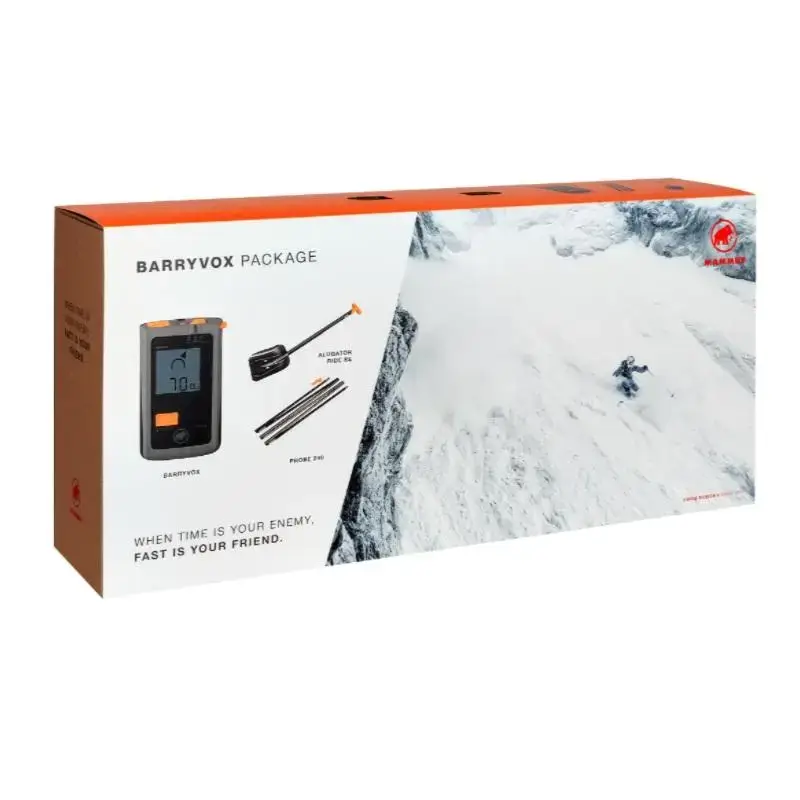One of splitboarding’s biggest thrills -- and biggest risks -- is adventuring on wild terrain, which is why avalanche safety gear should be top of mind no matter where you ride.
Although there’s plenty you can do to mitigate the risks of being caught in an avalanche, if the worst happens, you need to have reliable gear.
Whether your splitboarding friends are trying to find you under the snow, or you’re the one searching for and digging out a friend, proper avalanche safety gear dramatically improves the chances of a positive outcome.
In this post we’ll discuss essential avalanche safety gear for splitboarding. You’ll need a backpack to carry all the core pieces. You can find specific backcountry backpacks designed with special pockets for each of these pieces of gear, except the avalanche transceiver -- that one you need to carry on your person.
Throughout this post we’ll put special emphasis on the importance of professional avalanche courses. Avalanche safety requires special skills and they are critical in making sure you’re well prepared in the backcountry, both to help yourself and others.
AQ Outdoors Avalanche and Splitboarding Courses
Avalanche Safety Gear
Why is Avalanche Safety Gear Important?
Avalanche’s are no joke. If you or your friend find yourself buried in one, there’s a limited amount of time to find the person and dig them out. Avalanche pathways are long and wide -- without special gear you’d never scour one in time to find someone. Even if you did manage to locate their general area, you’d struggle to identify their exact position without a probe or dig them out without a shovel.
Recovering a person is virtually impossible without the right gear. And, when you do need to use avalanche safety gear, you’re fighting against the clock. You don’t want any of your gear to fail. That’s why it’s highly recommended to not only carry quality gear, but constantly check that it’s in working condition.
When someone is buried, the first thing you need to do is narrow down their location under the snow. This is why an avalanche transceiver is mandatory -- everyone in the splitboarding group carries one, and when someone is buried it begins sending a homing beacon. Then, you use your avalanche transceiver to guide yourself as close as possible to the buried person’s position.
Once you’re within a few feet of their general area, you need to learn how deep they are. This tells you where you need to start digging on the slope. Start too high, and you’ll miss them. Start too low, and you might run out of time before reaching them. All these techniques -- transceiver, probing, shovelling -- are technical. We only touch on them here, but a proper course is the best way to learn these skills.
You use a probe to determine how deep the person is buried. Then, you start digging. Once the person is located, first aid skills take over. This whole process can only start if you have the right gear.
Avalanche Transceiver
Mammut Barryvox Avalanche Transceiver

$475.00
Avalanche Safety Gear Guide Why Take an Avalanche Safety Training (AST) Course Practicing With Your Avalanche Rescue Gear: 4 Core Skills The‚ Mammut Barryvox Avalanche Transceiver is a digital three-antenna avalanche beacon trimmed down to all the essential functions. The… Read More
All avalanche transceivers, no matter the manufacturer, accomplish two things: send a signal if you get buried, or scan an area to find a buried person’s signal.
As avalanche transceivers go up in price, you pay extra for professional-level features like signal suppression and flagging multiple victims. Typically, you won’t find yourself in situations with multiple burials and if you do, you need specialized avalanche training to flag multiple locations.
If you’re on a budget, feel safe knowing that even the “basic” avalanche transceivers perform all the duties you need.
One important point: analog transceivers are not appropriate for backcountry and avalanche search. You need to have a 3 antenna digital transceiver. Luckily, we make this easy at Spltiboard HQ because that’s all we carry.
Avalanche Probe
Mammut Probe 280 Speed Lock

$109.00
Avalanche Safety Gear Guide Why Take an Avalanche Safety Training (AST) Course Practicing With Your Avalanche Rescue Gear: 4 Core Skills The‚ Mammut Probe 280 Speed Lock is a 280cm long, durable and light weight aluminum avalanche probe. It has… Read More
Once you know the general area of the person buried, you use an avalanche probe to determine how deep they are.
By plunging the probe into the snow in a systematic pattern, you learn the exact location of a person when your probe contacts them. Probes are designed to deploy extremely quickly. They also have depth markers, to help you determine where to start digging.
Like all the avalanche safety gear on this list, different avalanche probes produced by different companies are designed to function in all conditions, and perform effectively when you need them to. They also come in a variety of lengths and we recommend 280cm as being the minimum length. But, the longer the better.
Avalanche Shovel
Mammut Alugator Ride 3.0 Hoe

$100.00
Avalanche Safety Gear Guide Why Take an Avalanche Safety Training (AST) Course Practicing With Your Avalanche Rescue Gear: 4 Core Skills The‚ Mammut Alugator Ride 3.0 Hoe is an avalanche shovel and hoe all in one. Sometimes you need to… Read More
A proper avalanche shovel is the last piece of your “core” avalanche safety kit.
Beware of lower grade snow shovels sold at department stores for digging your vehicle out of snow banks: they are often cheaply made, heavy, and not designed for the rigours of avalanche digging.
Many of them have weak welds and are not designed to deploy quickly in emergency situations. And, they are not designed to pack flat in your backpack.
These are all reasons to buy an avalanche shovel that is designed for one thing -- digging through an avalanche to a buried victim. Your splitboarding days will also require the shovel for another important task: snow study. But that is another topic entirely.
Each manufacturer has its own variations, and some even have a couple different “modes”/ shapes in a single shovel. But even the basic ones are more than suitable to get the job done.
Avalanche Safety Airbags
Mammut Removable Airbag System 3.0

$650.00
Avalanche Safety Gear Guide Why Take an Avalanche Safety Training (AST) Course Practicing With Your Avalanche Rescue Gear: 4 Core Skills The Mammut Removable Airbag System 3.0 fits with the new Thule Upslope 35L pack to make a versatile backcountry… Read More
Although not part of the “core” kit for avalanche safety gear, the next items on the list are definitely worth consideration. An avalanche safety airbag is probably one of the first things that comes to mind when people think of improving their chances of surviving an avalanche.
One of these is not necessary, as proper avalanche awareness and trip planning should keep you well out of avalanche risk to begin with. But if you do find yourself in one, an airbag helps keep you at the surface.
You deploy the safety airbag as soon as you feel yourself getting overtaken by the rushing snow. The bag fills, and helps you float/ stay at the surface. The closer you are to the surface, the greater your chances of being found and rescued.
Avalanche safety airbags aren’t cheap, and definitely weigh more than a standard backpack. But if you want that extra piece of mind, they’re worth a closer look.
Splitboarding Helmet
Although highly recommended as a general safety item anytime you are cruising in the backcountry, a proper helmet can literally be the difference between life and death if you’re caught in an avalanche.
If the avalanche is shallow, and passes over rocks/ trees, there’s a good chance you’ll come into contact with one of these objects as you toss and tumble down the mountain.
Even if you aren’t in an avalanche, anytime you fall you always run the risk of hitting your head against a rock or terrain.
Any snowboard/ ski helmet will work perfectly for when you rip down a mountain in the backcountry.
Snow Study Equipment
BCA Snow Study Kit

$149.99
Avalanche Safety Gear Guide Why Take an Avalanche Safety Training (AST) Course Practicing With Your Avalanche Rescue Gear: 4 Core Skills BCA designed its Snow Study‚ Kit in conjunction with North America's most experienced avalanche educators. Backcountry Access Snow Study‚… Read More
Snow study is an optional piece of gear, but something to consider if you’re serious about assessing snowpack and want to gather as much info as possible when you’re in the backcountry.
These tools help you analyze snow crystals, cut extremely accurate snow blocks, assess snow temperature, and gain accurate slope readings.
Although this level of detail is typically reserved for intermediate to advanced splitboarders who already have snow analysis experience and want to gather precise information about a specific area, these tools are certainly something to keep in mind for your splitboarding pack.
Avalanche Safety Gear Summary
Whenever you’re splitboarding in the backcountry, avalanche safety gear are key pieces of equipment you don’t want to skimp out on, and always want to make sure are in working order.
An avalanche transceiver, avalanche probe, and avalanche shovel are absolutely critical and you need to make sure that everyone in your group has these, and knows how to use them.
The best way to learn how to use these tools, and recover someone buried in an avalanche, is to take an avalanche safety course. AQ provides both introduction and advanced avalanche courses, along with guide splitboarding trips.
The backcountry is a wild place, which is part of what makes it so fun. Just make sure you’re prepared for when you may find yourself in an emergency situation -- that’s not the time to wish you had proper avalanche safety gear.
And, as always, make sure you have proper avalanche safety training before heading into the backcountry, so you know how to use all of this gear properly.
AQ Outdoors Avalanche and Splitboarding Courses
Other Splitboarding Articles
Do I Need Specific Boots for Splitboarding?
Detailed Splitboard Boot Features
AQ Outdoors Contact
Edmonton: (p) 780 463-4892 (e) info@aquabaticsedmonton.com
Calgary: (p) 403 288-9283 (e) info@aqoutdoors.com
























































